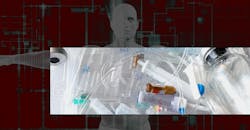Secure Authentication for Single-Use Medical Consumables (.PDF Download)
Today's medical instruments and their supporting equipment often incorporate single-use consumable sensors, cables, probes, and/or other peripherals. These devices are supplied to the user as sterile products, meaning the device has undergone a process of reducing pathogenic organisms from an object's surface that lead to disease (e.g., viruses, bacterium, fungi).
There are physical, chemical, and radiation methods to sterilize objects for medical applications. The process used is determined through factors such as material compatibility, process availability and location, regulatory approval, speed to market, and cost. For consumables that penetrate or otherwise make contact with a part of the human body, the defined low-sterility-assurance level (SAL—the probability that a single unit that’s subjected to sterilization nevertheless remains nonsterile) is typically at least 10-6, which is a 1 in 1,000,000 chance of a non-sterile unit.
